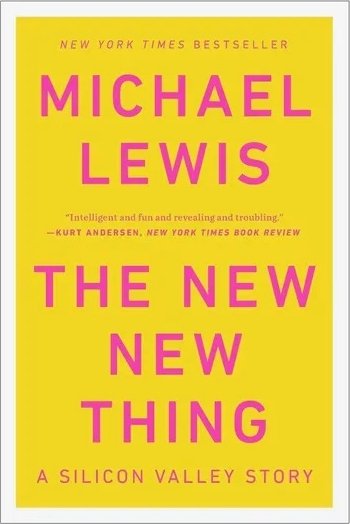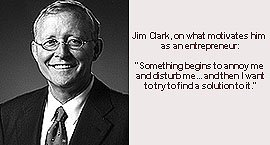
First off, I love anything by Michael Lewis (The Big Short, MoneyBall, The Blind Side). I say this not to point out potential review bias, but to draw attention to the fact that The New New Thing is just one in a string of incredible books by this author and, if you’re not reading Lewis already, I suggest you try him out.
Lewis’s interests focus on the intersection of finance, data, and tech and The New New Thing—an exploration/excoriation of dot-com era silicon-valley personalities, events and startup-culture through the story of one of it’s earliest pioneers, Jim Clark—is no different. This may sound like a rather dull area, but bear me out.
Michael Lewis has made a remarkable niche for himself telling the very human stories within business culture, while simultaneously dissecting the human absurdities, hubris and disfunction behind it. Whether that’s financial markets (The Big Short, Liar’s Poker, Boomerang), Sports (MoneyBall, The Blind Side) or Tech (Flash Boys, The New New Thing), if it’s seemingly boring and inscrutably complex, Lewis has tackled it in the most human and accessible way possible. You’ll probably recognize that several of the above have been turned into hit movies, which goes to show how well Lewis is able to tell stories about statistics, money and systems through the lens of its players.
This is one of Lewis’ earlier books and, given its age (the book predates smartphones and even Google!) and the speed of change within tech-innovation, you’d think the insights within might be stale. While there is a charming naiveté to the story, given everything that has happened since 1999, Michael Lewis’s immersion in the culture of that time presents a lens into the spark of a cultural shift (I might say psychotic episode) that would be almost vestigial in a modern day exploration of Silicon Valley. And hidden in there, in this place and this time, even perhaps unbeknownst to the writer and his subjects within, is a lot of interesting insight into one of the fastest, biggest and most disruptive forces impacting the modern day world.
The New New Thing is still a book worth reading—as much as Liar’s Poker, Lewis’ first book about the market crash in the 1980s, is still a timeless read—for anyone who wants to understand today through the lens of yesterday or to do that thing we all seem so increasingly incapable of (partially in thanks to the changes documented in The New New Thing), which is learning from the past.
Even as ‘startup-culture’ and the unending quest for “unicorns” and have spread across the globe, The New New Thing somehow still presents a fresh and brutally honest look at the cultures, personalities and economics that dominate Silicon Valley and the tech upheavals brought upon us by people who can never have enough.
In a way, given its current-at-the-time exploration of Silicon Valley, The New, New Thing presents a more primal and fundamentally pure exposé of startup culture than a book examining these issues today might. It does so by following Jim Clark, who having made millions of dollars inventing the first 3D-graphic chip (thus ushering in the 3D computer revolution), used it to make hundreds of millions founding Netscape (yes, the browser.) Unsatisfied with that, he attempts to blow up (nowadays we’d call it ‘disrupt’) the US healthcare system with Healtheon (later purchased by Microsoft and rebranded WedMD) while simultaneously trying to build a 100% automated yacht that he can sail from his computer over the internet. Along the way, Jim kicks off a long-overdue investigation into Microsoft’s anti-competitive practices and turns the old-gods of Wall Street on their head.

Through this book we see Jim Clark essentially prototyping the path that led to the Digital—or third phase—of the industrial technological revolution sweeping over us. In as many ways, Jim Clark is also the prototype for many of the tech entrepremillionaires that have followed in his footsteps, such as Elon Musk, Jeff Bezos and Mark Zuckerberg. For someone most people have never heard of today, Clark’s behaviour and psychosis made him uniquely fit to tie together all the disparate components needed to kick off this tech revolution and the chemtrails of his journey laid the foundations for the blueprint many follow today.
Society is still being tossed about by startup culture’s growth-fetishism—most recently with AI—and this book gives a pretty good picture of what’s actually going on down there, sociologically, and why it’s unlikely to stop as long as there are people like Jim Clark and financial groups that stand to make millions upon millions through disruption.
Regardless of whether the changes are good, or bad, technological revolutions are certainly moving faster than we can keep on top of, and the world, as a whole, seems incapable of helping itself, eagerly resigned to holding onto the bumper rather than sitting behind the wheel. This rapid disruption is largely to the financial benefit of a select few, and it is uncertain whether there is a net societal benefit in the short, medium and long terms. There are increasing signs that it might even be bad for us. Regardless, the downside of the disruption is owned by society alone, and not the disruptors who wrangle their technological and financial positions to maximize their own benefit. But all that’s the subject of a different book, one I hope someone will someday write.
Back to The New New Thing and away from my musings, the book offers yet another unique, fascinating, brilliantly told and deeply human entry from Michael Lewis and, if you’re at all interested in finance, business, entrepreneurship, or humanities collective quirks and failings, I’d highly recommend it, or any other Michael Lewis book.